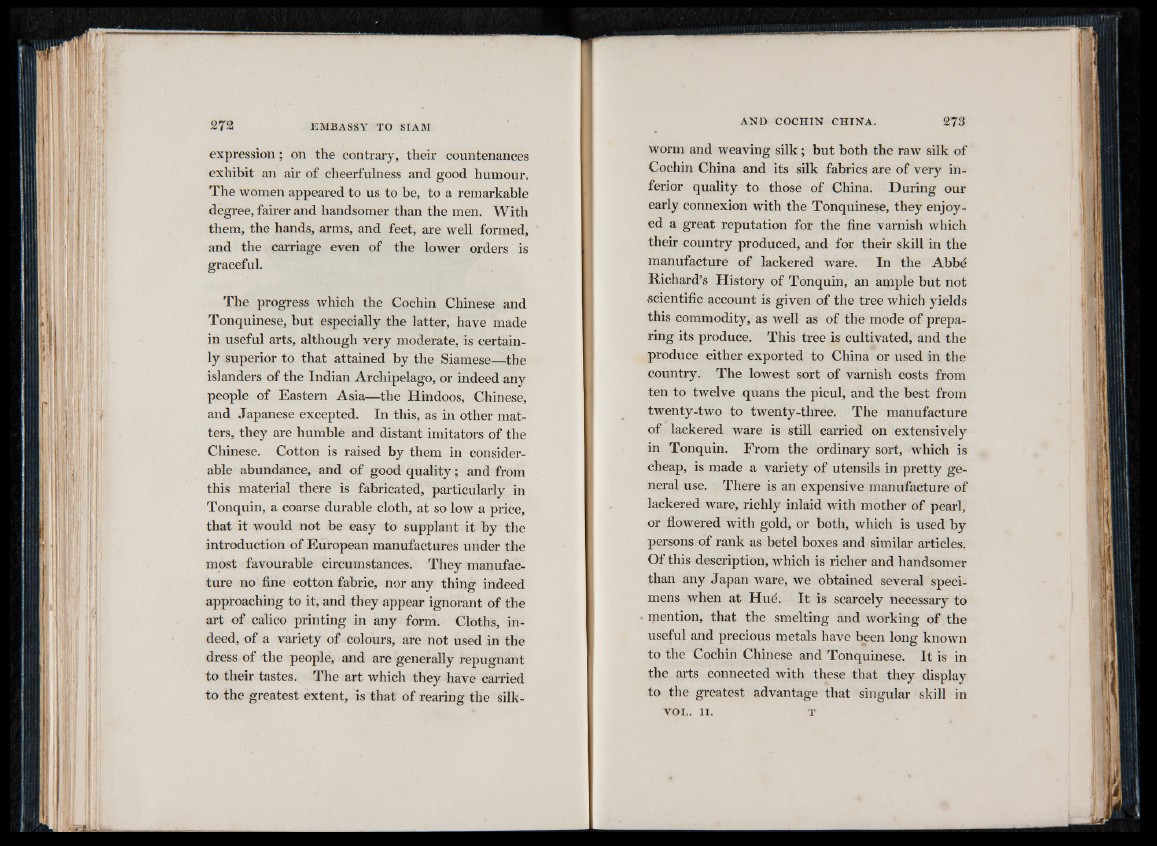
expression; on the contrary, their countenances
exhibit an air of cheerfulness and good humour.
The women appeared to us to be, to a remarkable
degree, fairer and handsomer than the men. With
them, the hands, arms, and feet, are well formed,
and the carriage even of the lower orders is
graceful.
The progress which the Cochin Chinese and
Tonquinese, but especially the latter, have made
in useful arts, although very moderate, is certainly
superior to that attained by the Siamese—the
islanders of the Indian Archipelago, or indeed any
people of Eastern Asia—the Hindoos, Chinese,
and Japanese excepted. In this, as in other matters,
they are humble and distant imitators of the
Chinese. Cotton is raised by them in considerable
abundance, and of good quality; and from
this material there is fabricated, particularly in
Tonquin, a coarse durable cloth, at so low a price,
that it would not be easy to supplant it by the
introduction of European manufactures under the
most favourable circumstances. They manufacture
no fine cotton fabric, nor any thing indeed
approaching to it, and they appear ignorant of the
art of calico printing in any form. Cloths, indeed,
of a variety of colours, are not used in the
dress of the people, and are generally repugnant
to their tastes. The art which they have carried
to the greatest extent, is that of rearing the silkworm
and weaving silk ; but both the raw silk of
Cochin China and its silk fabrics are of very inferior
quality to those of China. During our
early connexion with the Tonquinese, they enjoyed
a great reputation for the fine varnish which
their country produced, and for their skill in the
manufacture of lackered ware. In the Abbé
Richard’s History of Tonquin, an ample but not
scientific account is given of the tree which yields
this commodity, as well as of the mode of preparing
ita produce. This tree is cultivated, and the
produce either exported to China or used in the
country. The lowest sort of varnish costs from
ten to twelve quans the picul, and the best from
twenty-two to twenty-three. The manufacture
of lackered ware is still carried on extensively
in Tonquin. From the ordinary sort, which is
cheap, is made a variety of utensils in pretty general
use. There is an expensive manufacture of
lackered ware, richly inlaid with mother of pearl,
or flowered with gold, or both, which is used by
persons of rank as betel boxes and similar articles.
Of this description, which is richer and handsomer
than any Japan ware, we obtained several specimens
when at Hué. I t is scarcely necessary to
mention, that the smelting and working of the
useful and precious metals have been long known
to the Cochin Chinese and Tonquinese. It is in
the arts connected with these that they display
to the greatest advantage that singular skill in
VOL. II. T